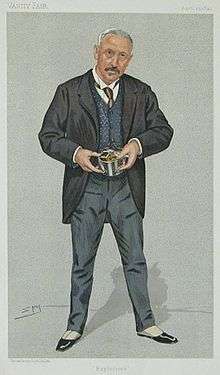Vivian Dering Majendie

Colonel Sir Vivian Dering Majendie KCB (18 July 1836 – 25 March 1898)[1] was one of the first bomb disposal experts[2] and Chief Inspector of Explosives to Queen Victoria from 1871 until his death in 1898.[3]
Biography
The son of Major John Routledge Majendie (1801–1850) and his wife Harriet Mary Dering (1806–1893),[4] and the grandson of Henry Majendie, the Bishop of Bangor, Vivian Majendie was educated at Leamington College before joining the Royal Artillery in 1854. Promoted to Second Lieutenant on 23 October 1854,[5] he saw action during the Crimean War and the Indian Mutiny. From 1861 to 1871 Majendie served as Captain Instructor and Assistant Superintendent at the Royal Arsenal at Woolwich. In 1871 he was appointed Chief Inspector of Explosives, a position he held until his death in 1898.[3] He was the President of the Association of Mining Engineers[6] and was one of the first bomb disposal experts.

As a Major in the Royal Artillery Majendie investigated an explosion on 2 October 1874 in the Regent's Canal when the barge 'Tilbury', carrying six barrels of petroleum and five tons of gunpowder blew up, killing the crew and destroying Macclesfield Bridge and cages at nearby London Zoo. He was appointed a Companion of the Bath (CB) in 1875 for framing a Bill which became 'The Explosives Act, 1875', and KCB in 1895.[7] His advice during the Fenian dynamite campaign of 1881-85[8] was officially recognised as having contributed to the saving of lives. After Victoria Station was bombed on 26 February 1884 he defused a bomb with a clockwork mechanism which might have gone off at any moment.[2]
In October 1886 Majendie visited the United States to observe the petroleum industry there and to examine the regulations regarding storage and distribution of that product.[9] A caricature of Majendie by Leslie Ward ('Spy') appeared in Vanity Fair on 23 April 1892. His publications included Up Among the Pandies (1859), Ammunition. A Descriptive Treatise on the Different Projectiles, Charges, Fuses, Rockets, &c. (1867), The Arms and Ammunition of the British Service (1868), and The Official Guide to the Explosives Act (1877).
Majendie married Adelaide Frances Grylls (1841–1866) and had two children, a daughter and Captain Henry Grylls Majendie (1865–1900) who was killed during the Boer War while serving with the Rifle Brigade.[4][10]
Vivian Dering Majendie died of heart failure in 1898 while visiting his sister in Oxford.[11]
References
- ↑ MAJENDIE, Sir Vivian Dering, Who Was Who, A & C Black, 1920–2016 (online edition, Oxford University Press, 2014)
- 1 2 'Death of a Distinguished Officer' - National Library of New Zealand
- 1 2 Obituary in The New York Times April 25, 1898
- 1 2 Vivian Dering Majendie on Ancestry.com
- ↑ The London Gazette: no. 21621. p. 3363. 7 November 1854.
- ↑ Col. Sir Vivian Dering Majendie R.A.
- ↑ The London Gazette: no. 26639. p. 3740. 2 July 1895.
- ↑ Armitage, Tom 'Bombing trains is nothing new - it is what 19th-century anarchists did' - The New Statesman 8 August 2005
- ↑ 'Interested In Petroleum: Col. Majendie Looking Into That Product And Also Dynamite' The New York Times October 10, 1886
- ↑ Officers Died: South Africa 1899 - 1902
- ↑ 'Death of Colonel Majendie: A Brave Inspector' National Library of New Zealand
External links
- 'Death of Colonel Majendie' in the National Library of New Zealand website
- Portraits of Sir Vivian Dering Majendie at the National Portrait Gallery, London

- The Majendie Family Crest on My Family Silver website